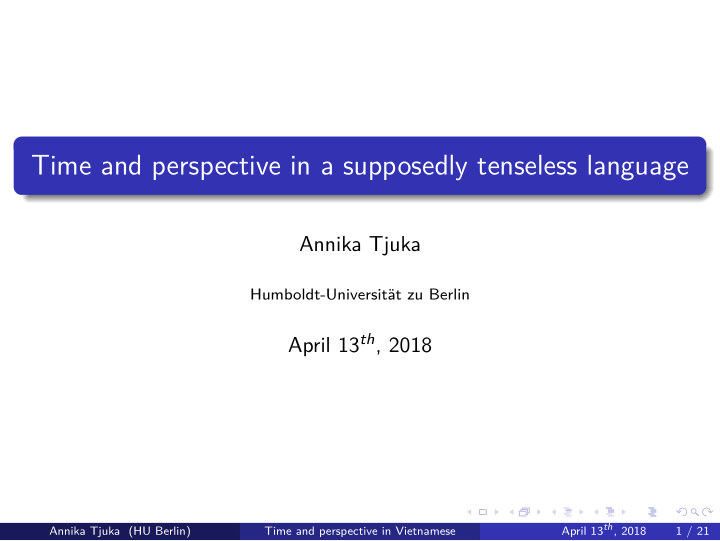



Time and perspective in a supposedly tenseless language Annika Tjuka Humboldt-Universit¨ at zu Berlin April 13 th , 2018 April 13 th , 2018 Annika Tjuka (HU Berlin) Time and perspective in Vietnamese 1 / 21
Overview Vietnamese 1 Tense 2 Elicitation study 3 Conclusion 4 April 13 th , 2018 Annika Tjuka (HU Berlin) Time and perspective in Vietnamese 2 / 21
Vietnamese April 13 th , 2018 Annika Tjuka (HU Berlin) Time and perspective in Vietnamese 3 / 21
April 13 th , 2018 Annika Tjuka (HU Berlin) Time and perspective in Vietnamese 4 / 21
Vietnamese Dialects divided into southern, middle and northern dialect 70 million native speakers in Vietnam und almost 1 million speakers in other countries Austroasiatic language family Sound system consisting of 6 tones ( giá ”price“; già ”old“) Analytic language No marking of case, number and genus April 13 th , 2018 Annika Tjuka (HU Berlin) Time and perspective in Vietnamese 5 / 21
Tense April 13 th , 2018 Annika Tjuka (HU Berlin) Time and perspective in Vietnamese 6 / 21
Tenselessness Tenselessness is understood as the absence of obligatory tense marking in finite clauses. (1) a. I went to the university. b. #I go to the university yesterday. April 13 th , 2018 Annika Tjuka (HU Berlin) Time and perspective in Vietnamese 7 / 21
Tense and aspect in Vietnamese Vietnamese is known to be a tenseless language. BUT there are tense and aspect markers in Vietnamese: April 13 th , 2018 Annika Tjuka (HU Berlin) Time and perspective in Vietnamese 8 / 21
Future marker Tôi nấu phở gà. (2) sẽ 1.SG FUT cook soup chicken ‘I will cook chicken soup.’ April 13 th , 2018 Annika Tjuka (HU Berlin) Time and perspective in Vietnamese 9 / 21
Past marker Năm ngoái tôi đến newyork. (3) đã year last 1.SG PST go New.York ’I was in New York last year.’ April 13 th , 2018 Annika Tjuka (HU Berlin) Time and perspective in Vietnamese 10 / 21
Progressive marker Tôi làm buổi sáng. (4) đang 1.SG PROG make CLF.day morning ’I’m making breakfast.’ April 13 th , 2018 Annika Tjuka (HU Berlin) Time and perspective in Vietnamese 11 / 21
Elicitation study April 13 th , 2018 Annika Tjuka (HU Berlin) Time and perspective in Vietnamese 12 / 21
Elicitation study – Research questions Do Vietnamese native speakers use tense and aspect markers in spoken conversations? And if so, are these markers optional or obligatory in contexts which differ in terms of time reference and aspect? April 13 th , 2018 Annika Tjuka (HU Berlin) Time and perspective in Vietnamese 13 / 21
Elicitation study – Participants 3 male participants, all Vietnamese native speakers with English as their secound language (after the age of 6) Age: 18-25 years One speaker of the northern dialect and two speakers of the southern dialect April 13 th , 2018 Annika Tjuka (HU Berlin) Time and perspective in Vietnamese 14 / 21
Elicitation study – Material 10 contexts in different tense and aspect categories: past, present, future stative, perfective, progressive, habitual April 13 th , 2018 Annika Tjuka (HU Berlin) Time and perspective in Vietnamese 15 / 21
Elicitation study – Material E.g. for past, perfective context: (5) Sarah and Joe are looking through a photo album. Sarah sees a photo of Joe standing infront of the statue of Liberty. Sarah asks Joe: ”Did you go to New York last year?“Joe answers: ” Yes, I went to New York last year. “ April 13 th , 2018 Annika Tjuka (HU Berlin) Time and perspective in Vietnamese 16 / 21
Elicitation study – Results Figure: Results of elicitation study April 13 th , 2018 Annika Tjuka (HU Berlin) Time and perspective in Vietnamese 17 / 21
Elicitation study – Results sẽ was used consistently in all contexts with future reference đang was used in almost every context with progressive aspect đã wasn’t used consistently throughout different contexts that referred to the past April 13 th , 2018 Annika Tjuka (HU Berlin) Time and perspective in Vietnamese 18 / 21
Conclusion April 13 th , 2018 Annika Tjuka (HU Berlin) Time and perspective in Vietnamese 19 / 21
Conclusion optionality of tense and aspect markers in Vietnamese differs clearly between markers the marker đang is also used in the present, stative context by one participant, therefore it could an imperfective marker further research on the future marker sẽ could prove that it is obligatory –> supporting the hypothesis that Vietnamese isn’t a tenseless language after all April 13 th , 2018 Annika Tjuka (HU Berlin) Time and perspective in Vietnamese 20 / 21
Literature Goddard, Cliff (2005). The languages of East and Southeast Asia: an introduction. Matthewson, L. (2006). Temporal semantics in a superficially tenseless language. Linguistics and Philosophy 29(6), 673–713. Ngo, T. (2010). Interpretation of temporal relations in narrative in tenseless languages: The case of Vietnamese. UWA Linguistics Working Papers, 1. Thompson, Laurence C. (1991). A Vietnamese reference grammar. April 13 th , 2018 Annika Tjuka (HU Berlin) Time and perspective in Vietnamese 21 / 21
Recommend
More recommend